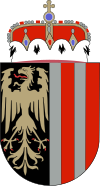Alte Austrie
| Alte Austrie | |
|---|---|
| Non ufiziâl: | Oberösterreich |

|

|
| Stât: | Austrie |
| Cjâflûc: | Linz |
| Superficie: | 11.982 km2 |
| Popolazion: - Totâl - Densitât |
(2017) 1.465.045 ab. 122 ab./km2 |

| |
| Sît istituzionâl | |
La Alte Austrie e je un dai stâts federâts austriacs (tod. Bundesländer). E je logade tal nord dal paîs e e confine a jevât cun la Basse Austrie, a sud cun la Stirie, a bonât cun il Salisburghês e tal nord cun la Gjermanie (Baviere) e cun la Republiche Ceche (Boemie meridionâl). La capitâl e je Linz (197.283 ab. ce.); altris citâts impuartantis a son: Ansfelden, Bad Hall, Bad Ischl, Braunau am Inn, Enns, Eferding, Gmunden, Freistadt, Leonding, Marchtrenk, Mattighofen, Ried im Innkreis, Rohrbach, Schärding, Traun, Steyr, Vöcklabruck, Wels.
Gjeografie
cambieLa mont plui alte dale Alte Austrie e je la Hoher Dachstein (2995 m).
Storie
cambie- 1254 (Pâs di Ofen) o 1261 (Pâs di Viene) – Il re Ottokar II di Ongjarie al divid la regjon dal Traungau dale Stirie e le ricree come “Principât sore il flum Enns” (tod. Fürstenthum ob der Enns). Tal 1264 al ven usât la prime volte il non latin "Austria superior" (tod. Oberösterreich) o "supra Anasum" (voltât: sore il flum Enns).
- Dal 1490 – La regjon al rive a un cert nivel di autonomie.
- 1530 – Al tache a difondisi la dotrine protestante; 30 agns plui tard la maiorance dale popolazion e je evangeliche.
- 1564 – La regjon e finis il domini dai Asburcs.
- Daspò il 1600 – I imperadôrs Rodolf II e Matie a fasin jentrâ in vigôr la Controriforme; par chest i rangs dale Alte Austrie a fasin un pat cun i paîs dale Boemie. A vegnin batûts tal 1620 dal princip eletôr dale Baviere Massimilian par cont dal imperadôr Ferdinand II.
- 1779 – Cun la pâs di Teschen la zone dal Innviertel e passe dale Baviere ale Alte Austrie.
- 1814-1854 – Linz e aministre ancje il teritori dal Salisburghês.
- 1918 – Oberösterreich al devente il non ufiziâl dal stât.
- 1939 – A seguit dale anesion dale Austrie ale Gjermanie naziste la Alte Austrie e ven unide ai teritoris gjavâts al sud dale Boemie cul Acuard di Monaco: al ven cussì creât il gnûf distret dal “Oberdonau”.
- 1945 – Cun la fin dale Seconde vuere mondiâl al ven ricostistuît il stât federâl dale Alte Austrie.
Economie
cambieConfrontât cun il prodot intern lord dale Union Europeane in forme di podê di acuist, la Alte Austrie e à un indis di 112.8 (EU-25:100) (2003). [1]
Organizazion aministrative
cambieTradizionalmentri la Alte Austrie e ven dividude talis cuatri areis dal Hausruckviertel, dal Innviertel, dal Mühlviertel e dal Traunviertel. Ultimamentri il teritori tra lis citâts di Linz, Eferding, Wels, Steyr, e Enns al ven clamât aree centrâl (tod. Zentralraum).
Dal pont di viste aministratîf e je dividude in 3 citâts statutariis (tod. Statutarstädte) e 15 distrets (tod. Bezirke):
| Citâts statutariis | Targhe |
|---|---|
| Linz | L
|
| Steyr | SR
|
| Wels | WE
|
| Distrets | Targhe |
|---|---|
| Braunau am Inn | BR
|
| Eferding | EF
|
| Freistadt | FR
|
| Gmunden | GM
|
| Grieskirchen | GR
|
| Kirchdorf an der Krems | KI
|
| Linz-Land | LL
|
| Perg | PE
|
| Ried im Innkreis | RI
|
| Rohrbach | RO
|
| Schärding | SD
|
| Steyr-Land | SE
|
| Urfahr-Umgebung | UU
|
| Vöcklabruck | VB
|
| Wels-Land | WL
|
Situazion politiche
cambieDal 1995 il governadôr (tod. Landeshauptmann) dal Burgenland al è Josef Pühringer, dal ÖVP (Österreichische Volkspartei, voltât "Partît popolâr austriac").
Risultivis
cambie
| Länder austriacs | ||
|---|---|---|
|
Burgenland • Carintie • Alte Austrie • Basse Austrie • Salisburghês • Stirie/Staiar • Tirol • Vorarlberg • Viene | ||